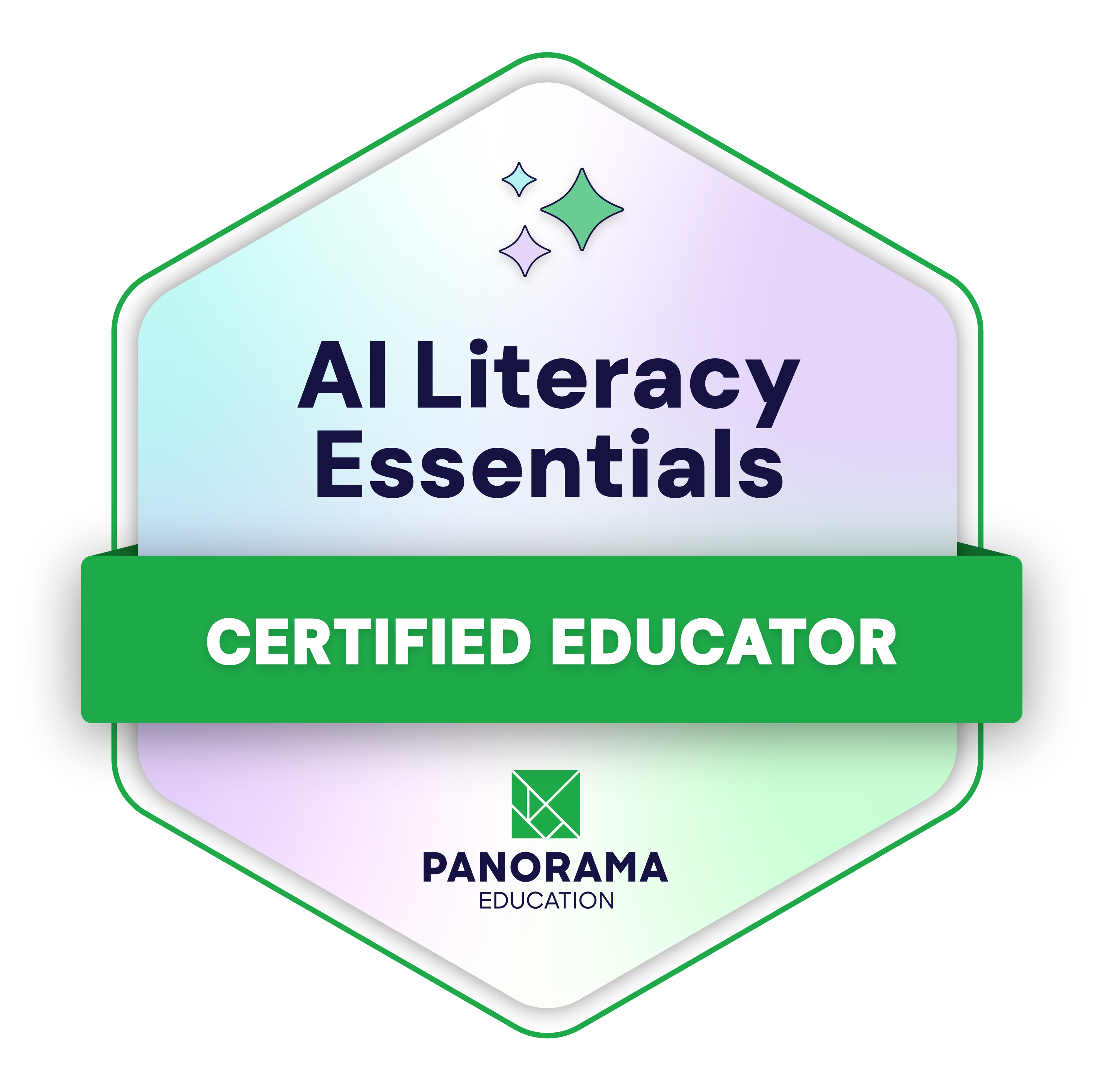Intervention planning is a cornerstone of any effective MTSS—but it’s also one of the most resource-intensive responsibilities schools face. Leaders know the challenge: teams are juggling data, compliance, and capacity, all while trying to deliver targeted support to the students who need it most.
AI is beginning to shift what’s possible. Even free, general-purpose tools like ChatGPT can help educators brainstorm interventions and structure plans more efficiently. And for many schools, that’s an important first step.
But when your team needs intervention plans that are student-specific, data-informed, and aligned to your district’s MTSS framework, ChatGPT can only go so far.
In this post, we’ll show you how to create an intervention plan with both a general AI tool and Panorama Solara, Panorama’s secure, educator-aligned AI platform. You’ll see what each approach can offer, and why Solara gives your team a faster, safer way to turn insight into action.
Why Use AI for Intervention Planning?
Intervention planning is where strategy meets execution, but getting it right takes time and expertise. Educators may spend hours gathering data, writing goals, selecting supports, and ensuring every plan meets district and state guidelines. Multiply that by dozens or even hundreds of students, and the workload becomes unsustainable and students lose out on valuable learning opportunities..
That’s where AI can play a meaningful role. When used thoughtfully, AI can:
- Speed up planning by drafting baseline intervention plans in seconds
- Reduce cognitive load by synthesizing data points and surfacing relevant insights
- Support consistency by aligning plans with MTSS tiers, frameworks, and documentation norms
- Save valuable time for teachers, counselors, and intervention teams — without sacrificing quality
Of course, AI isn’t a replacement for educator judgment—it’s a tool to help your team spend less time piecing together data and more time supporting students. The key is choosing an AI solution that works with your systems, honors your data privacy requirements, and reflects your MTSS approach.
How to Create an Intervention Plan with AI
-
Identify the student’s needs
Use academic, attendance, and behavior data to pinpoint where support is required. -
Generate a draft plan with AI
Use a clear, structured prompt to create an appropriate plan. -
Review and refine
Check for accuracy and adherence to district best practices. -
Customize goals and strategies
Tailor the interventions to the student’s context, strengths, and compliance requirements.
In the sections below, we’ll break each of these steps down — showing how to do them with both a general-purpose AI tool and Solara, and why the right platform makes all the difference.
Step-by-Step Intervention Planning with AI
You don’t need a premium tool to get started with AI. Even a free assistant like ChatGPT can help educators save time on intervention planning. Below, we walk through the process using ChatGPT—and show how Solara makes each step more powerful by connecting directly to your district’s data and MTSS systems.
1. Identify the Student’s Needs
With ChatGPT:
You’ll need to manually gather data from your SIS, behavior logs, attendance records, and any relevant notes from staff. But here’s the key limitation: you cannot include any personally identifiable student information (PII) in your prompt. Free AI tools like ChatGPT are not FERPA-compliant, and sharing student information with them may violate federal law — and more importantly, it puts student privacy at risk.
To protect students and maintain trust, educators should avoid sharing any specific data points, names, or identifiable details in general-purpose AI tools. That means you’ll need to summarize the student’s needs in broad terms (e.g., “a 9th grade student with frequent absences and low math performance”), which limits the tool’s ability to provide targeted support.
With Panorama Solara:
Solara connects directly to your district’s data systems and operates within existing data privacy agreements. It securely pulls in full student context—including attendance, academic performance, and behavior data—so you can generate a meaningful, personalized intervention plan without compromising on data security.
2. Generate a Draft Plan
With ChatGPT:
Once you’ve summarized the student’s needs (without including any identifying information), you can enter a prompt like:
“Create a Tier 2 intervention plan for a 9th grade student who is struggling with attendance and math. Include goals, strategies, and progress monitoring.”
ChatGPT will generate a general plan based on your input. While this can be a helpful starting point, the draft won’t reflect your school or district’s MTSS framework, available supports, or preferred language. You’ll likely need to edit it heavily to ensure it aligns with your local practices.
With Panorama Solara:
A teacher can select a student from their class roster, choose an intervention focus area (like behavior), and add any additional context or guidance. Using one of Solara’s custom tools for intervention planning, they can generate a plan tailored to that student’s needs in just a few clicks.
Custom tools in Solara are district-created, reusable AI workflows designed for common educator tasks, like drafting attendance plans, generating instructional materials, or building intervention plans. In this example, Solara analyzes the selected student’s integrated data alongside the educator’s instructions and produces a tailored list of evidence-based strategies aligned with the PBIS framework, along with a corresponding action plan.
Because the tool is built and configured at the district level, the output is aligned with local frameworks, expectations, and language, ensuring educators start from a strong, usable draft that reflects how your team already works.
Depending on the specifications of your district’s intervention planning custom tool, a draft plan might include:
- Tier-appropriate goals
- A list of evidence-based interventions aligned to the selected focus area (e.g., behavior, attendance, academics)
- A corresponding action plan tailored to the individual student
- Built-in progress monitoring suggestions
Because Solara is built specifically for K–12, the draft plan isn’t just a helpful starting point—it’s usable. It reflects the way your district documents, communicates, and tracks interventions, saving your team time and reducing rework.
3. Review and Refine
With ChatGPT:
Once the draft plan is generated, you’ll need to read through it carefully. Check that the strategies are developmentally appropriate, match the right MTSS tier, and align with your district’s intervention expectations. Because ChatGPT—or other generic AI tools—don’t use your district’s frameworks or language, you may need to significantly rewrite the supports or formatting to meet documentation standards.
Even small details like terminology (e.g., “Check-In/Check-Out” vs. “daily mentor contact”) or phrasing for measurable goals often require manual adjustment.
With Solara:
Solara generates your intervention plan using your district’s existing frameworks and language, giving you a strong, time-saving starting point. Goals and strategies are automatically aligned to the correct MTSS tier, and the draft mirrors how your district already writes and documents plans, including compliant progress-monitoring language.
Of course, educator review remains essential. Solara is designed to save time on formatting and structure so teams can focus their attention where it matters most: reviewing, personalizing, and making the final call on student supports.
You can still personalize the plan with a few clicks, but you’re starting from a strong, context-aware draft that’s ready to use and easy to collaborate on.
4. Customize Goals and Strategies
With ChatGPT:
If the initial draft includes vague or overly broad strategies (e.g., “provide academic support” or “build rapport”), you’ll need to follow up with additional prompts like:
“Make the strategies more specific and evidence-based”
“Include progress monitoring methods aligned to Tier 2 supports”
This back-and-forth can be time-consuming and still may not reflect what’s feasible or approved in your school. You may also need to manually cross-reference district resources, intervention libraries, and documentation norms.
With Solara:
Solara suggests interventions and goals that are tailored to your district’s approved practices, MTSS tiers, and frameworks like PBIS or RTI.
Plans are automatically customized based on the selected student’s data and the intervention focus area, whether academic, behavioral, or attendance-related.
Getting Started with AI-Powered Intervention Planning
AI won’t replace the expertise of educators, but it can make it faster and easier to put that expertise into action. With the right tools, your team can spend less time on documentation and more time doing what matters most: supporting students.
Whether you're just beginning to explore how AI fits into your MTSS strategy or you're ready to bring a secure, educator-aligned solution to your district, Panorama Solara makes it easy to take the next step. Built with privacy, compliance, and real educator workflows in mind, Solara helps schools and districts unlock the time-saving power of AI without compromising what matters.
Ready to see Panorama Solara in action? Schedule a demo today and discover how AI can help your teams create stronger intervention plans—faster, safer, and with less lift.
Not ready for a district-wide AI solution just yet? No problem. Check out our Free AI Roadmap for District Leaders. It’s packed with tools to help you lead with confidence, including:
-
100+ AI prompts for educators and support staff
-
An AI buyer’s guide to help you evaluate platforms
-
Practical planning tools to set your vision and build momentum
Whether you're ready to implement or just starting to explore, we're here to help you unlock the promise of AI in education.




.png?width=3300&height=1100&name=District%20Leader%20%20Broad%20Promo%20Email%20-%20FINAL%20(1).png)
.jpg)
.jpg)

